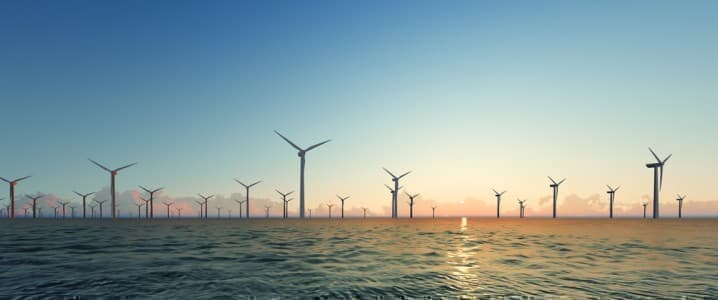Scotland has auctioned off parts of its seabed to wind energy companies, raising $951 million and propelling the country’s renewable energy industry. But some are questioning whether it’s the right move to sell Scotland’s significant wind energy potential to private companies.
As part of the auction, 17 projects were selected from 74 applications for an area of seabed totaling 7,000km2as part of the Scottish Government’s Sectoral Marine Plan. This marks the first offshore leasing round in over a decade. Scottish Power Renewables invested $194.2 million across several sites, while Shell spent almost $161.2 million on one 2,000MW site. BP Alternative Energy Investments and SSE Energy also invested, each offering funds of $116 to construct 2,907 and 2,610 MW projects. The total potential energy from these auctions equates to powering approximately 23 million U.K. homes a year.
Laying the foundations for companies to establish as much as 25GW of offshore wind capacity, Scotland hopes to rapidly expand its renewable energy sector. At present, the U.K. produces around 10GW of offshore wind, with plans to expand this figure to 40GW by 2030. Auction revenues will go back to the Scottish Consolidated Fund to finance the Scottish government. In addition, the successful bidders agreed to invest around $1.34 in materials and services from Scotland for every 1GW of offshore wind capacity, supporting local companies.
CEO of Scottish Power, Keith Anderson, explained, “This is a colossal investment opportunity which could make this the biggest industrial investment programme in history for Scotland.” He also highlighted the potential for massive opportunities for universities and technology innovators to work alongside the wind energy industry.
Shell and Scottish Power will be working together on won two sites with wind energy totaling 5GW off the east and north-east coast of Scotland under two joint ventures - MarramWind and CampionWind. This could help provide power to 6 million homes.
Anderson stated of the partnership, “Offshore wind is set to become the backbone of the UK’s energy mix and will do the heavy lifting as we ramp up the production of clean electricity on the journey to net-zero. Our ScotWind projects will make the best use of our fantastic natural resources to help power the UK’s transition from fossil fuels to renewables and a better future, quicker.” Adding, “this is a pivotal moment that will reinforce the UK’s position as the global leader in offshore wind and give a significant boost to the economy.” “We’re excited to have the green light to kick start our plans and look forward to working with Shell and our supply chain partners – who can get in touch now – to bring the world’s first large-scale floating windfarms to UK waters,” he concluded.
As the U.K. pledges to move away from fossil fuels to renewable alternatives, aiming for net-zero by 2050, this marks an important moment in the shift. Scotland hopes to independently achieve net-zero even earlier, by 2045, aiming to decreases its major greenhouse gas emissions by 75 percent by 2030.
As the government attracts a high level of private investment in wind farms, they could produce enough wind power to meet much of the country’s energy demand. The Scotsman newspaper suggested that the capacity up for sale at the recent auction could mean the production of ten times as much much energy as the former Longannet power station.
Claire Mack, CEO of Scottish Renewables, tried to explain the significance of the auction, “It is hard to illustrate the scale of the opportunity by discussing gigawatts alone, but the numbers are remarkable. Just before Christmas, the Longannet power station chimney in Fife was demolished…For almost 50 years, Longannet generated around a quarter of Scotland’s electricity with 2.4GW of capacity.” She highlighted the need to ensure the necessary grid capacity for the new energy production, to carry out studies and manage projects to decrease the potential impact on wildlife such as birds and marine life, and to collaborate across the supply chain.
Related: It’s Full Speed Ahead For The World’s Most Exciting Oil Play
Despite the generally positive response to the auctions, some are wondering whether Scotland is missing a trick by leasing its seabeds to foreign companies rather than establishing a national wind-energy company. Common Weal, a pro-independence think tank, believes that Scotland is “repeating the mistake” of its oil history by selling the rights rather than setting up a national energy giant to manage its energy portfolio.
Common Weal’s Craig Dalzell stated, “Had Scotland launched a national energy company capable of owning ScotWind, it would have been well placed to deliver billions in profits to Scotland every year that will now instead be shipped overseas to private shareholders or invested in the public services of those countries who have deployed their own nationalized companies in Scotland.”
One thing is certain, it is vital that private wind energy projects consider the supply chain carefully, providing jobs and economic growth to a Scotland that is moving away from oil and gas. The country continues to rely heavily on fossil fuels to provide jobs and bring in revenues. In the shift to renewables, it is important that those working in oil and gas are given the opportunity to retrain and transition to the green energy sector. By redeveloping the country’s energy sector with strong investment from oil majors working alongside Scottish Power, Scotland could see significant opportunities across its economy as its wind sector expands exponentially.
By Felicity Bradstock for Oilprice.com
More Top Reads From Oilprice.com:
- Tight Physical Crude Market Points To Higher Oil Prices
- Oil Prices Stable After API Reports Small Crude Draw
- OPEC+ Set To Continue With 400,000 Bpd Production Increase


















